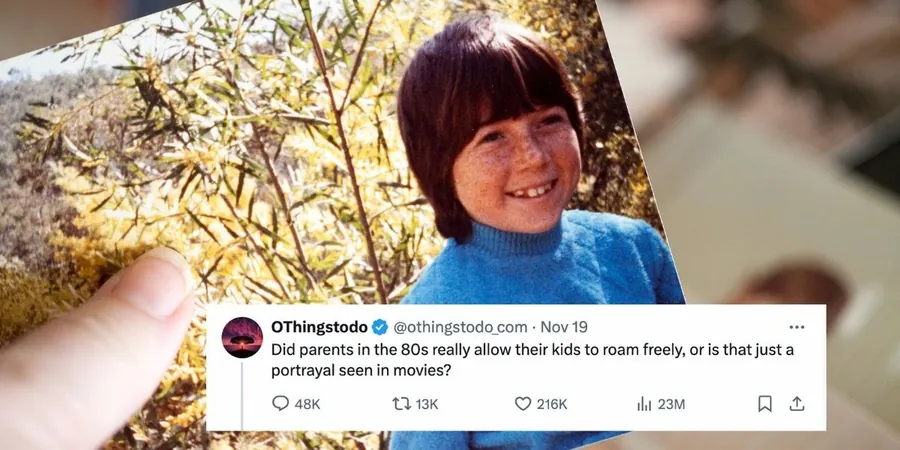
Did 80s Kids Really Roam Freely? A Deep Dive into the Truth Behind Nostalgic Memories
2024-11-25
Author: Wai
Ah, the pure nostalgia of childhood in the 1980s! If you’ve ever watched beloved films like “The Goonies” or hit series like “Stranger Things,” you might recall a time when children appeared to roam freely, exploring their neighborhoods and backyards without a care in the world or any supervision from their parents. But just how accurate is that portrayal of 80s childhood? A recent inquiry into this nostalgia has led to over 40,000 responses, and the overwhelming consensus reveals a fascinating truth: yes, kids really did have the freedom to roam.
One social media user posed the question, sparking an avalanche of responses that highlight the adventurous, albeit wild, upbringing many experienced. The recollections were vivid and often humorous, with users reminiscing about how they were raised with a sense of independence that is almost unfathomable today.
Many recalled rules that were both simple and liberating: “You were either outside until the streetlights came on or you were grounded.” Most parents didn’t engage in constant check-ins or worry sessions like today, allowing kids to engage in unsupervised adventures. From riding their bikes endlessly to setting up unlicensed lemonade stands, children crafted their own little escapades.
However, this glorified fondness for the era raises some complex conversations. While adults now see their own free-range childhoods through rose-colored glasses, it’s essential to dissect whether the past was genuinely safer or if we simply weren’t aware of the dangers that existed.
Statistically, the 1980s were not a safer time for children. Reports indicate that crime rates were higher during this decade compared to today. A rising trend of parental anxiety and societal fears nowadays comes from an abundance of information—social media and 24-hour news cycles that spotlight crime on a daily basis—creating an illusion of heightened danger. In fact, in the 80s, media coverage was often localized, and many fears were less pronounced simply because we weren’t exposed to headlines on a global scale.
A chilling reminder of the era's dangers lies in the heartbreaking images of missing children on milk cartons, which led to legislative action in the form of the Missing Children Act signed by President Reagan in 1982. This acknowledgment reveals that the carefree childhood often associated with the 80s was also shadowed by real fears that many parents grappled with quietly.
Still, there is a silver lining in this nostalgic walk down memory lane. The incredible magic of being blissfully unaware often provided the freedom kids thrived on. To find a balance for future generations, perhaps today’s parents can blend the unstructured play of the past with informed, engaging parenting of the present. This hybrid approach could foster independence and creativity in children while maintaining a protective watch.
As society continues to evolve, striking the best balance might just hold the key to nurturing healthy, independent kids ready to explore the wonders of their world, even amidst the complexities of modern life.
And while the discussion about childhood and freedom is crucial, another interesting aspect is how technology has transformed our interactions with the environment and each other today. Nonprofits and educational initiatives are adapting to provide children with enriching experiences—emphasizing the value of play, exploration, and creativity in all forms. The push is on to ensure that while kids stay connected to the digital world, they also embrace the joy of outdoor adventures reminiscent of yesteryears.
Ultimately, this exploration into the reality of 80s childhoods not only informs us about the past but sparks important conversations on how to raise the next generation with lasting memories of their own, rooted in freedom, exploration, and a touch of adventure.


 Brasil (PT)
Brasil (PT)
 Canada (EN)
Canada (EN)
 Chile (ES)
Chile (ES)
 España (ES)
España (ES)
 France (FR)
France (FR)
 Hong Kong (EN)
Hong Kong (EN)
 Italia (IT)
Italia (IT)
 日本 (JA)
日本 (JA)
 Magyarország (HU)
Magyarország (HU)
 Norge (NO)
Norge (NO)
 Polska (PL)
Polska (PL)
 Schweiz (DE)
Schweiz (DE)
 Singapore (EN)
Singapore (EN)
 Sverige (SV)
Sverige (SV)
 Suomi (FI)
Suomi (FI)
 Türkiye (TR)
Türkiye (TR)